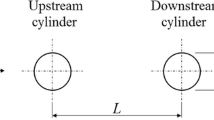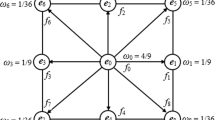Abstract
Numerical simulations of flows past the piggyback circular cylinders in tandem arrangement are performed by solving the variational multiscale formulation of the incompressible Navier–Stokes equations using in-house finite element method (FEM) codes. The effects of the gap-spacing-to-diameter (G/D) and the two diameter ratio (d/D) on the flow characteristics and the reductions of the root-mean-square (RMS) drag and lift coefficients are considered for Reynolds numbers (Res) are 100 and 200. The validation shows the fluid force coefficients obtained by the in-house FEM codes are in good agreement with the results in the existing literatures. The obtained results show that, with a proper placement of the smaller cylinder (\(d/D=0.2\)) behind the larger cylinder, the RMS drag and lift coefficients largely decrease compared to those of the single circular cylinder. When \(d/D=0.2\), the largest reductions of the RMS lift coefficient of the larger cylinder and the RMS total lift coefficient appear at \(G/D=1.2\) as Re \(=100\) and at \(G/D=1.0\) as Re \(=200\). It is observed that the proper placement of the smaller cylinder causes the surrounding vorticity to take opposite sign with the vorticity in the outer region so as to suppress and postpone the vortex shedding in the wake, and that the different positions of the vortex shedding at two Res cause that the largest reductions of the RMS lift coefficient of the larger cylinder and the RMS total lift coefficient appear at different G/D as Re is different. When d/D varies, the variation of the RMS total lift coefficient behaves differently at two Res. It decreases with d/D increasing at Re \(=100\), while it no longer monotonously varies with d/D, but reaches a minimum in the considered range of d/D at Re \(=200\). Moreover, the larger d/D results in stronger suppression and postponement of the vortex shedding in the wake.
Graphic abstract
The effects of the gap-spacing-to-diameter and the two-diameter ratio on the flow characteristics and the reductions of the root-mean-square (RMS) drag and lift coefficients are investigated by stabilized finite element method. With a proper placement of the smaller cylinder behind the larger cylinder, the RMS drag and lift coefficients are smaller than those of the single circular cylinder. The proper placement of the smaller cylinder causes the surrounding vorticity to take opposite sign with the vorticity in the outer region so as to suppress and postpone the vortex shedding in the wake.















Similar content being viewed by others
References
Wu, B., Bachina, D., Fan, D., et al.: Vortex-induced vibration of a piggyback pipeline half buried in the seabed. J. Sound Vibr. 449, 182–195 (2019)
Brankovic, M., To/rnes, K., Zeitoun, H., et al.: Dynamic stability response of piggyback pipelines. In: Proceedings of the ASME 2010 29th International Conference on Ocean, Offshore and Arctic Engineering (2010)
Zeitoun, H., Sutherland, J., Brankovic, M., et al., Physical modelling of hydrodynamic loads on piggyback pipelines in combined wave and current conditions. In: Proceedings of the ASME 2010 29th International Conference on Ocean, Offshore and Arctic Engineering (2010)
Igarashi, T.: Characteristics of a flow around two circular cylinders of different diameters arranged in tandem. Bull. JSME 25(201), 349–357 (1982)
Wong, P., Ko, N.: Flows past two circular cylinders of different diameters. J. Wind Eng. Ind. Aerodynam. 41, 563–564 (1992)
Wong, P., Leung, R., Ko, N.: Interaction of flow structures within bistable flow behind two circular cylinders of different diameters. Exp. Therm. Fluid Sci. 12(8), 33–44 (1996)
Sreenivasan, K., Strykowski, P.: On the formation and suppression of vortex ‘shedding’ at low reynolds numbers. J. Fluid Mech. 218, 71 (1990)
Sengupta, T., Talla, S., Dipankar, A.: Suppression of vortex shedding behind a circular cylinder by another control cylinder at low reynolds numbers. J. Fluid Mech. 573, 171–190 (2007)
Haniu, H., Sakamoto, H.: Optimum suppression of fluid forces acting on a circular cylinder. J. Fluids Eng. 116(2), 221 (1994)
Xu, Y., Owen, J., Dalton, C.: The suppression of lift on a circular cylinder due to vortex shedding at moderate reynolds numbers. J. Fluids Struct. 15(3–4), 617–628 (2001)
Kamemoto, K., Tsutsui, T., Igarashi, T.: Interactive flow around two circular cylinders of different diameters at close proximity. Experiment and numerical analysis by vortex method. J. Wind Eng. Ind. Aerodynam. 69–71, 279–291 (1997)
Cheng, L., Teng, B., Zhao, M., et al.: Numerical simulation of viscous flow past two circular cylinders of different diameters. Appl. Ocean Res. 27(1), 39–55 (2005)
Cheng, L., Teng, B., Zhao, M., et al.: Hydrodynamic forces on dual cylinders of different diameters in steady currents. J. Fluids Struct. 23(1), 59–83 (2007)
Duan, M., Gu, J., Song, Z.: Hydrodynamics and vortex shedding characteristics of two tandem cylinders of different diameters in steady flow. Ships Offshore Struct. 12, 1–14 (2015)
Zhao, M., Cheng, L., Thapa, J., et al.: Three-dimensional flow around two circular cylinders of different diameters in a close proximity. Phys. Fluids 27(8), 39–55 (2015)
Cheng, L., Bin, T., Zhao, M.: Numerical modeling of flow and hydrodynamic forces around a piggyback pipeline near the seabed. J. Waterway Port Coast. Ocean Eng. 133(4), 286–295 (2007)
Gao, F., Cui, J., Zang, Z.: Physical modeling and swirling strength analysis of vortex shedding from near-bed piggyback pipelines. Appl. Ocean Res. 40, 50–59 (2013)
Hughes, T.J.R.: Multiscale phenomena: Greens̈ functions, the dirichlet-to-neumann formulation, subgrid scale models, bubbles and the origins of stabilized methods. Comput. Methods Appl. Mech. Eng. 127(1–4), 387–401 (1995)
Feijo, G., Mazzei, L., Hughes, T.J.R., et al.: The variational multiscale method—a paradigm for computational mechanics. Comput. Methods Appl. Mech. Eng. 166(1–2), 3–24 (1998)
Hu, X.Q., Chen, L.F.: A pod-based variational multiscale method for large eddy simulation of turbulent channel flows. Int. J. Comput. Methods 14(5), 1750049 (2017)
Chen, G.X., Wu, L.F.: Boundary shear flow past a cylinder near a wall. Appl. Ocean Res. 92, 101923 (2019)
Hulshoff, S.J., Wang, Y.T., Chen, L.F.: 2D residual-based les of flow around a pipeline close to a flat seabed. Comput. Meth. Appl. Mech. Eng. 363, 112788 (2020)
Wang, Y.T., Sun, S.Y., Chen, L.F., et al.: The effect of boundary shear flow on hydrodynamic forces of a pipeline over a fully scoured seabed. Ocean Eng. 206, 107326 (2020)
Hughes, T.J.R., Oberai, A.A., Holmen, J., et al.: Sensitivity of the scale partition for variational multiscale large-eddy simulation of channel flow. Phys. Fluids 16(3), 824–827 (2004)
Khurram, R.A., Masud, A.: A multiscale finite element method for the incompressible Navier–Stokes equations. Comput. Methods Appl. Mech. Eng. 195(13–16), 1750–1777 (2006)
Sangalli, G., Hughes, T.J.R.: Variational multiscale analysis: the fine-scale green’s function, projection, optimization, localization, and stabilized methods. SIAM J. Numer. Anal. 45(2), 539–557 (2007)
Franca, L.P., Tezduyar, T.E., Behr, M.A.: Stabilized finite element methods for the velocity–pressure–stress formulation of incompressible flows. Comput. Methods Appl. Mech. Eng. 104(1), 31–48 (1993)
Hughes, T.J.R., Johan, Z., Shakib, F.: A new finite element formulation for computational fluid dynamics: X. the compressible euler and Navier–Stokes equations. Comput. Methods Appl. Mech. Eng. 89(1–3), 141–219 (1991)
Calderer, R., Masud, A.: A variational multiscale method for incompressible turbulent flows: bubble functions and fine scale fields. Comput. Methods Appl. Mech. Eng. 200(33–36), 2577–2593 (2011)
Goraya, S.A., Masud, A., Zhu, L.: Interface-capturing method for free-surface plunging and breaking waves. J. Eng. Mech. 145(11), 04019088 (2019)
Whiting, C., Hulbert, G., Jansen, K.: A generalized-alpha method for integrating the filtered Navier–Stokes equations with a stabilized finite element method. Comput. Methods Appl. Mech. Eng. 190, 305–319 (2000)
Michler, C., Calo, V., Bazilevs, Y., et al.: Isogeometric variational multiscale modeling of wall-bounded turbulent flows with weakly enforced boundary conditions on unstretched meshes. Comput. Methods Appl. Mech. Eng. 199(13–16), 780–790 (2010)
Tan, Z.R., Lin, L.M.: DNS in evolution of vorticity and sign relationship in wake transition of a circular cylinder: (pure) mode A. Acta Mech. Sin. 35(6), 1131–1149 (2019)
Kang, S.: Characteristics of flow over two circular cylinders in a side-by-side arrangement at low reynolds numbers. Phys. Fluids 15(9), 2486–2498 (2003)
Sigrist, J., Hamdouni, A., Placzek, A.: Numerical simulation of vortex shedding past a circular cylinder in a cross-flow at low Reynolds number with finite volume-technique: Part 1—forced oscillations. In: Proceedings of the ASME Pressure Vessel and Piping Division Conference, pp. 11–20 (2007)
Zhong, X.F., Wu, Y.X., Lin, L.M.: Effect of perforation on flow past a circular cylinder at Re =100: vortex-shedding pattern and force history. Acta Mech. Sin. 34(2), 238–256 (2018)
Zhong, X.F., Wu, Y.X., Lin, L.M.: Effect of perforation on flow past a conic cylinder at Re = 100: vortex-shedding pattern and force history. Acta Mech. Sin. 34(5), 812–829 (2018)
Sotiropoulos, F., Borazjani, I.: Vortex-induced vibrations of two cylinders in tandem arrangement in the proximitycwake interference region. J. Fluid Mech. 621, 321–364 (2009)
Wu, G.X., Jiao, H.: Analysis of fluctuating force acting on two cylinders in different arrangements through lattice Boltzmann method. J. Fluids Struct. 82, 101–120 (2018)
Acknowledgements
The project was supported by the Natural Science Foundation of Jiangsu Province (Grant SBK2018040999), the Natural Science Research of Jiangsu Higher Education Institutions of China (Grant 18KJB570001) and the National Natural Science Foundation of China (Grants 51879123 and 91852111).
Author information
Authors and Affiliations
Corresponding author
Additional information
Executive Editor: Guo-Wei He.
Rights and permissions
About this article
Cite this article
Chen, L., Dong, Y. Numerical investigation on fluid forces of piggyback circular cylinders in tandem arrangement at low Reynolds numbers. Acta Mech. Sin. 37, 599–612 (2021). https://doi.org/10.1007/s10409-020-01037-z
Received:
Revised:
Accepted:
Published:
Issue Date:
DOI: https://doi.org/10.1007/s10409-020-01037-z




